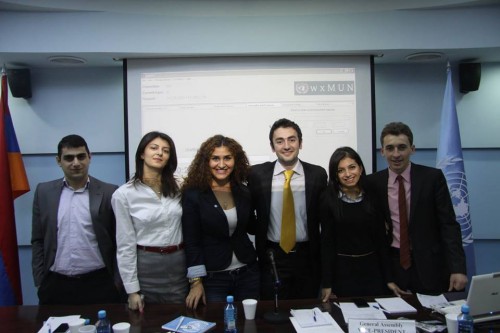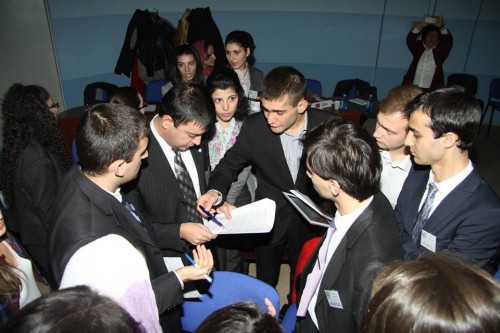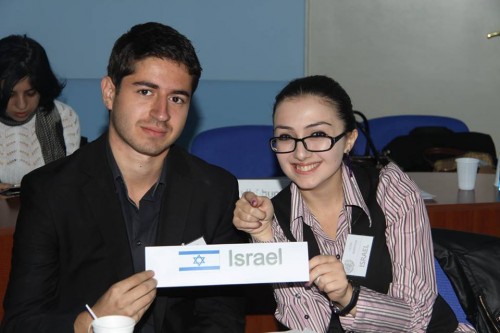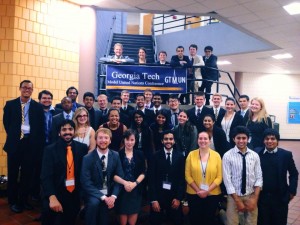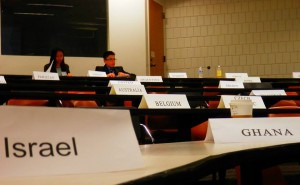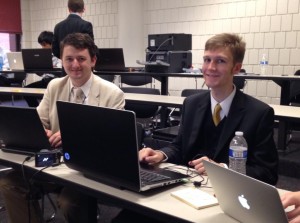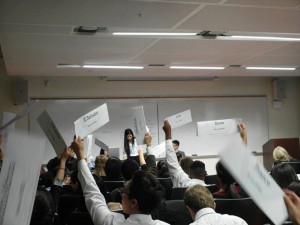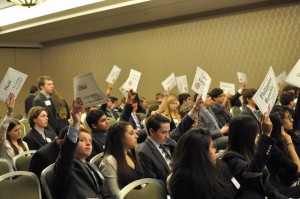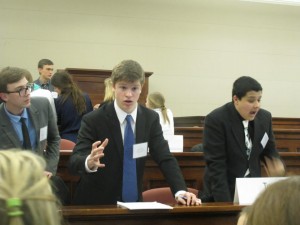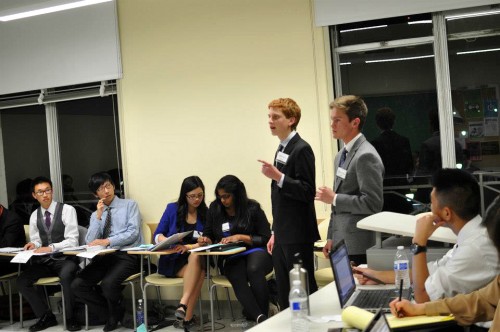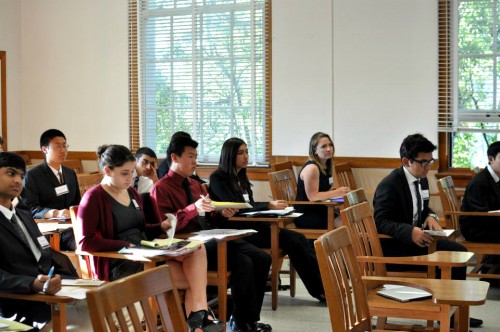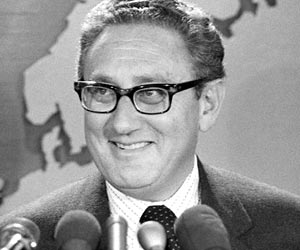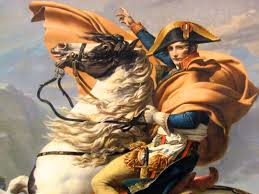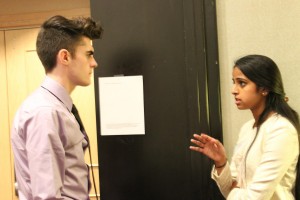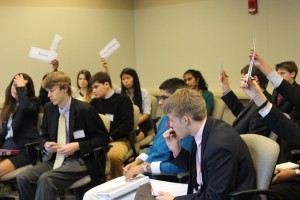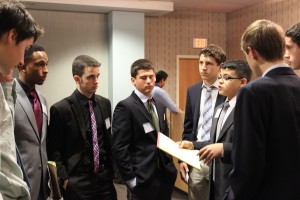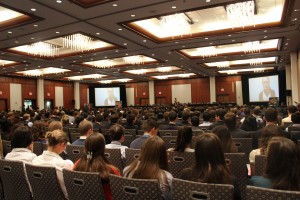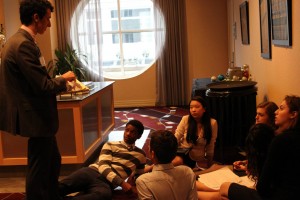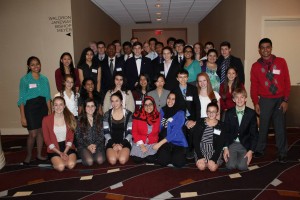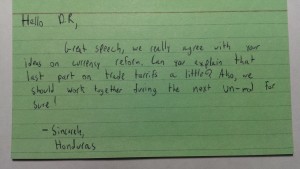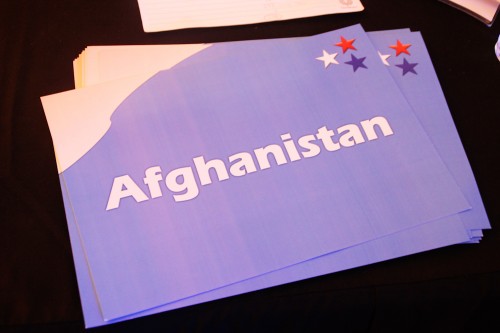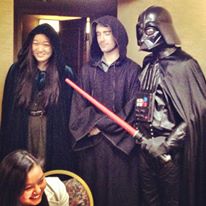Which college Model UN teams are the best on the circuit? There are many definitions of success in Model UN, and awards are not the purpose of Model UN. Nevertheless, they do tell us which teams are doing well and our rankings are meant to recognize teams for their accomplishments at conferences throughout the school year.
Methodology: The methodology is the same as in previous years with minor modifications in weightings to reflect attendance this year. The article above also provides insight into the purpose and philosophy behind the rankings.
- Disclaimer: Note that only teams that participate at university-hosted conferences that emphasize awards are included in the dataset, and we can only use data that is available to us. This ranking is not meant to capture all of college MUN as many good teams participate at conferences that do not value the competitive aspect of Model UN.
- Credits: Thank you to Best Delegate Media Manager Mari Manoogian for collecting the awards data and quotes.
Without further ado, here is the Top 25 for fall 2013:
1. University of Chicago
![The University of Chicago is the number one team on the college circuit this fall after winning the Best Large Delegation at UPMUNC and NCSC. Pictured here: the team at UPMUNC.]()
The University of Chicago is the number one team on the college circuit this fall after winning the Best Large Delegation at UPMUNC and NCSC. Pictured here: the team at UPMUNC.
The University of Chicago is the number one team on the college circuit this fall, and the competition has not been even close when it comes to aggregate scoring. UChicago narrowly lost to Georgetown by the weighted score equivalent of a verbal commendation at CMUNNY but still started its season strong with an Outstanding Large Delegation award there. It then defeated defending circuit champion UPenn at NCSC to win the Best Large Delegation award and topped Georgetown at UPMUNC to capture the Best Large Delegation award at the fall championship. Despite a wide lead in aggregate scoring, their top rank for the season is still very much up for grabs, as they will have a rematch with UPenn, Yale, and others for best large delegation honors at HNMUN. The team will also host ChoMUN in the spring.
UChicago had their sights set high at the beginning. Eric Wessan, the UChicago head delegate, shares that “this year, the University of Chicago had a goal to maintain and improve in our past success. We wanted to bring more people to more conferences, and we wanted to have our caliber of delegate to be the best that it could be. Throughout this fall, we have trained both during the week and on weekends to ensure that everyone, particularly those who had not done college Model United Nations or MUN at all were as prepared as possible. While obviously there are great improvements that still yet remain, I am very proud of our team, which has put in more heart and effort than I could have ever hoped.”
2. Georgetown University
Georgetown had the spotlight to begin the season as it won Best Large Delegation at CMUNNY over UChicago, Harvard, UPenn and others. It then followed up with a third place finish at SCSY where it received the most gavels of any team. After hosting NCSC, Georgetown went on to win the Outstanding Large Delegation award at UPMUNC ahead of Harvard, Yale, and others. Georgetown and UChicago went 1-1 in head-to-head matchups with UChicago winning the more competitive conference. The two teams will not get a chance to go head-to-head again at another large conference as Georgetown will attend McMUN and UChicago will attend HNMUN and host ChoMUN. Therefore, the race between these two will come down to aggregate scoring across the circuit.
However, Georgetown’s goals are not only on the awards. Sam Brothers, the head delegate for the Hoyas, explained, “I’m tremendously pleased with how the semester’s gone for Georgetown’s team. When I was running for head delegate, I recognized that balancing our team’s desire to win with allowing everyone in the broader Georgetown community to have the opportunity to travel with the team would be difficult, but with the help of conferences staff, I think we’ve pulled it off! I’m so proud of everyone’s performances this fall, and I can’t wait to see what the team’s going to do in the spring semester!”
3. Harvard University
Harvard may not have hardware in the fall to show for their efforts, but they have been putting on strong performances as a large delegation and achieved their highest rank ever since the rankings started. Harvard contended for a large delegation award at four competitive conferences this fall – the team finished third at CMUNNY, fourth at SCSY, third at NCSC, and third at UPMUNC. Members of the team will take a break from competing as delegates to help staff several conferences around the world in the next few months including three college-level conferences: HNMUN Latin America in Brazil in January, HNMUN in Boston in February, and WorldMUN in Brussels in March. Nina Chen and Katherine Ebright lead the Harvard team.
4. University of Pennsylvania
UPenn put in a solid performance and received three Outstanding Large Delegation awards out of four conferences it attended this fall semester. The first two actually took place on the same weekend when the team split its delegation. It won one at SCSY, where the team outscored Best Large Delegation award winner Columbia in terms of weighted points. It won the second at BarMUN behind Michigan State. It then followed up with a third one at NCSC behind UChicago. In addition, the team finished fourth at CMUNNY behind the three teams ranked above it. UPenn also hosted UPMUNC, the fall championship on the college circuit. Although the Best Large Delegation award has alluded the team this fall semester, it is still possible for them to achieve the top rank on the college circuit if they can defend their Best Large Delegation award at HNMUN, especially given that Harvard and UChicago have yet to host and Georgetown does not attend HNMUN. Head delegate Akhilesh Goswami will lead the UPenn team in their attempt to regain their top rank.
5. Florida International University
FIU and West Point are going head-to-head again for best small delegation supremacy. FIU won the Outstanding Small Delegation award at UPMUNC, the Best Small Delegation award at NCSC, and the Outstanding Small Delegation award at CMUNNY. Although FIU lost to West Point at UPMUNC and to an in-state rival, the University of Florida, for the first time in a while at CMUNNY, the team has been the most consistent among the small delegations and aggregate scoring kept them among the top five teams of the college circuit. FIU will meet West Point and other top teams again at HNMUN. Mark Hodgson once again leads the FIU team.
6. United States Military Academy at West Point
West Point is one of the elite best small delegations on the circuit and proved it by winning the Best Small Delegation award at UPMUNC ahead of FIU. West Point also finished tied for fifth at SCSY and in sixth place at NCSC. In addition, the team traveled to OxIMUN, hosted by Oxford, and captured the Best Small Delegation award there. In addition to a challenging schedule that includes HNMUN and WorldMUN, West Point will be hosting WPMUNI in the spring. Brandon Moore is serving as the head delegate for West Point this year, but credits his team for their motivated efforts. Moore explains, “West Point has been fortunate to have had some outstanding recruiting this year. The prerogative for preparation lies entirely with the individual members, so our success during the fall semester demonstrates a lot of personal motivation.”
Moore has also been impressed with the quality and collegiality on the college circuit this year, noting “though Model UN is a competition, it’s much more about establishing those lasting relationships with professional young adults around the globe. West Point specifically focuses on furthering greater civil-military understanding with our civilian counterparts, and we have been truly impressed with everyone’s professionalism and charisma this year.”
7. Claremont McKenna College
Claremont McKenna is either the most dominant team in your region or a rapidly rising top small delegation depending on which coast you reside in. On the West Coast, the gap between CMC and its rivals has only widened. CMC took home seven of eleven gavels and almost half of all weighted points at SBIMUN – that’s more than the next three teams (Berkeley, Stanford, and USC) combined. The team may not be as dominant on the East Coast yet, but its reputation has grown after winning Outstanding Small Delegation at NCSC and after putting in a solid performance at UPMUNC on back-to-back weekends after SBIMUN. Head delegates Kanupriya Rungta and Ankit Sud lead the CMC team. “It’s been amazing to see how enthusiastic everyone on the team is- our performance is a testament to the hard work each member has put in, especially since our team is so young. We are very excited for next semester,” Rungta, said.
8. Columbia University
Columbia is fielding its best team in recent years, and this young team has potential to climb into the top five. After kicking off the college season by hosting CMMUNY, Columbia went to SCSY and upset large delegation powerhouses UPenn, Georgetown, and Harvard to win the Best Large Delegation award. The team completed a successful fall semester with awards at UPMUNC, NCSC, and BarMUN. Columbia usually fields a small delegation, and it notably finished right behind top small delegations FIU and West Point and ahead of Claremont McKenna in terms of weighted score at NCSC. Chris Crant and Michael Ying lead Columbia’s team “Columbia’s MUN team in the recent past has experienced the unfortunate effect of large talented senior classes graduating. As a result, we have had to consistently field young teams,” said Crant. “However this trial by fire has begun to pay dividends this year, and the new deeper outreach program that was implemented this year will only serve as a complement. Thus, I am extremely excited about the future of this team and its unbridled potential.”
9. Yale University
The Yale team, also known as MUNTY, remains in the top ten after a fourth place finish at UPMUNC behind only UChicago, Georgetown, and Harvard. It also got on the scoreboard at NCSC and it hosted SCSY to start off its season. The big disparity between Yale’s performances at UPMUNC and NCSC may be due to Yale’s traditional strength in General Assembly committees. If so, then it will be an advantage for the team heading into HNMUN where it will try to challenge UChicago and UPenn for the Best Large Delegation award. Head delegate John Sununu leads MUNTY.
10. Rutgers University
With the exception of its performance at CMUNNY where it won some awards, the Rutgers team has finished in the top ten at SCSY, NCSC, and UPMUNC this semester. The team was able to attend UPMUNC this semester as their high school RUMUN conference moved to December, and the team finished particularly strong with 8 out of 9 delegates winning awards. Overall, its success puts Rutgers into the top ten on the college circuit. Internally, Rutgers has met many of its goals for the fall season. Head delegate Danial Manzoor explains, “We had delegates in committee that were passionate and truly cared about each and every topic they faced. The mix of the new pool of freshmen alongside with our returning veterans has really made me proud of my delegation. We have challenged ourselves individually and as a team at every conference. I speak on behalf of every Rutgers delegate when I say that our delegates have made life-long college memories, had fun at every conference, and made friends all over the circuit.”
11. Boston University
BU started the season by hosting BarMUN, and then put on a very strong performance at the end of October with a fourth place finish at NCSC behind only UChicago, UPenn, and Harvard and ahead of the small delegation award winners. In addition, BU added a solid performance at UPMUNC to cap its fall semester. The head delegate for BU, Katrina Trost, said of her team “BU has an extremely young team this year, and I have to say I’m very proud of the new delegates’ progress and the continued strong performance of veteran members. We’ve expanded our standing team and changed up our training process, and I’m looking forward to see how this impacts our awards and success in the spring, and in coming years.”
12. New York University
NYU had several strong performances this fall semester. The team continues to put in high-level performances at crosstown CMUNNY, and this year it finished in the top five there behind Georgetown, UChicago, Harvard, and UPenn. The team next got on the scoreboard at NCSC before rebounding with a top ten performance at UPMUNC. Kamal Tamboli, Abhishek Chandra, and Isabelle Klinghoffer lead the NYU team. The team will also host NYUMUNC in the spring.
13. Michigan State University
Michigan State is having one of its best starts ever highlighted by an upset of UPenn for Best Large Delegation honors at BarMUN. In addition, the team finished in the top ten at UPMUNC, proving that it can compete against the best and that the BarMUN performance was not just a smaller-conference fluke. Chris Bourdganis leads the MSU team and reflected on the team’s performance. “This is my 8th year of Model United Nations and I can honestly say our team’s trip to BarMUN this year and winning our first best large delegation award there has been the best MUN experience of my life. Our executive board is all extremely proud of all of our delegation, rookies and veterans alike,” said Bourdganis.
14. McGill University
McGill is having one of its best seasons ever. It started its season with a top-five finish at SCSY behind only UPenn, Columbia, Georgetown, and Harvard. It then took home some awards at NCSC and ended its fall semester on a high note by winning Best Small Delegation at CIAC ahead of Canadian rival Queen’s University. In fact, they had the highest weighted score of any team at CIAC. “The McGill delegations team has reached a new level in their dedication to preparation and training, which has translated to the team’s success in the fall semester,” said head delegate Emmett Meacher. “As the team continues to improve their skills, both on and off the circuit, we are looking forward to competition and another successful semester.” Of course, many other delegates are looking forward to attending McMUN when the season resumes from winter break.
15. The George Washington University
GW was missing a lot of its veteran leadership from its past classes of Colonial Cadets as they have been engaged in study abroad or internships this fall semester. That made it more difficult for a freshman-heavy team of Colonial Cadets to excel. However, the team still held its own by winning multiple awards at UPMUNC, NCSC, SCSY, and CMUNNY. Head delegate David Berris seeks to build on the success of their previous head delegate, Jared Greenspan, and said, “I hope to continue this exemplary form of leadership and make a statement with the momentum that we are carrying with us. GW will persevere as one of the top schools on the circuit with our graduated classes of cadets, now upperclassman, and our newly added cadets who are beginning to understand what a prestigious circuit they find themselves in.”
16. University of Florida
Florida had a strong fall season. Most notably, the team won the Best Small Delegation at CMUNNY ahead of in-state rival FIU, showing potential that the pecking order between the four competitive Florida college teams could soon change. Florida also finished in the top ten at UPMUNC to bolster its resume. In addition to its successes on the university-hosted World Division circuit, the team also came home with an Outstanding Delegation (first place) and Distinguished Delegation (second place) at SRMUN. Head delegates Chris Joyce, Troy Robinson, Aaron Kalafarski, and Fred Kolb lead the UF team. “It is really gratifying to receive recognition for our performance this semester. We have learned to balance the ‘work hard, play hard’ mentality. Competition wise, UF has a program to be reckoned with and our performance will only improve going forward,” Robinson said.
17. University of California, Berkeley
In the team’s eighteenth season on the college circuit, head delegates Mahith Amancherla and Apratim Vidyarthi set out the goals for the team to “aim to take UCBMUN where no man has gone before, by expanding on the training schedule, club-subsidization system, and implementing a rigorous CIA-analyst style testing system for the club, which brings together a diverse range of 110 club members.” In terms of performance, Berkeley won awards at CMUNNY and UPMUNC and again captured the Outstanding Large Delegation award at SBIMUN. Although there was a large gap between them and Best Large Delegation Claremont McKenna, the team has to be satisfied with its large haul of awards and significant distance ahead of third-place Stanford at SBIMUN. Berkeley will host UCBMUN in the spring.
18. University of Miami
Miami is putting in top-ten caliber performances. This helped them take home the Outstanding Small Delegation award at SCSY and a finish just outside the top ten at UPMUNC. Head delegate Skip McClinton cited how fun is part of the formula to the team’s success this year. “To turn a team into a family, all the pieces have to be there. The personalities, the passion, the fun, the hard work, all of which bonds distinct people together into a unit.” In terms of the future, head delegate Marie Hanewinckel remarked that “we are proud of the personal and skill growth of our squad, which has been mixed with amazing times one would expect from the Miami team. We cannot wait to face and overcome the obstacles ahead as a team, as a family.”
19. The College of William & Mary
William & Mary has some high expectations after winning two major delegation awards at the end of last spring, and this fall’s performance has not fallen short of the expectations of head delegate Connor Smith. W&M won the Outstanding Delegation award at DISCon behind Tulane and also won awards at UPMUNC, NCSC, and CMUNNY. The team is young, and they expect to grow in both size and quality in preparation for McMUN. The team will also host &MUN in the spring. “This season, I’m so proud that we sent over 70 delegates to 4 conferences, won our first Fall delegation award in almost 5 years, and had an overall rewarding, awesome time! I’m excited to gear up for our more competitive spring season and to continue building our talent base, especially in our amazing freshman class,” said Smith.
20. Emory University
Emory may not be winning the upper tier of delegate awards, but they are fielding teams that are winning numerous awards at each conference and the team has displayed consistency across UPMUNC, NCSC, CMUNNY, and DISCon. The team co-President, Pritika Gupta, said of the team’s performance, “ We laid a solid foundation for the large incoming class – which is also a good reminder that the team is growing at such a fast rate – and I think that was the best thing we could do to move forward. There are incredible amounts of potential within these kids and I’m already looking forward to next semester with them.” Kate Cyr and Maria Alvarez will take over head delegate responsibilities in the spring.
21. Clark University
Clark had a busier than usual fall semester by winning awards at CMUNNY, SCSY, BarMUN, and UPMUNC. They have traditionally been stronger in General Assembly conferences instead of the crisis-oriented ones that are more typical in the fall, so they may have a better chance to shine when they get to HNMUN. However, the focus of Clark’s team is less on awards and more on the experience of learning diplomacy. Head delegate Yohan Senarath explains that the Clark team “believes that diplomacy is a study of the human being. Our members are encouraged to study themselves. By understanding themselves better, they are essentially in a better position to engage with others around them.” Head delegate Patrick Burchat also leads Clark.
22. The Ohio State University
Ohio State breaks into the Top 25 for the first time ever in only its second year on the college circuit after winning several awards at the two most competitive conferences of the fall in UPMUNC and NCSC. They are also the third team from the Midwest to ever get ranked – the others are powerhouse UChicago and Big Ten leader Michigan State. Head delegate Erik Leiden recapped the experience of his young team. “Through some incredibly hard work, Midwestern charm, and personalized, dialogue-driven strategy sessions, members of Ohio State’s Collegiate Council on World Affairs have had their best performances yet this Fall…while maintaining our policy of being a 100% guaranteed Good Time. Go Bucks!”
23. Stanford University
The highlight of Stanford’s fall quarter was winning the Best Small Delegation award at SCSY. It was their first best delegation award on the East Coast in several years, and perhaps the team is starting a trend having won a delegation award at CMUNNY around the same time last year. Stanford also got on the scoreboard at NCSC and finished fourth in their fall West Coast matchup at SBIMUN behind Claremont McKenna, Berkeley, and USC. Alex Richard and Johan Bonilla are the head delegates for Stanford. Richard said of their performance this fall, “we’re very proud of our team’s dedication and hard work, which allowed our majority-freshman team to succeed across a wide variety of committees.”
24. Boston College
Boston College made the Top 25 rankings this fall with a third place finish behind only Michigan State and UPenn at cross-town BarMUN and by getting onto the scoreboard at CMUNNY. Head delegate Braeden Lord continues to build BC’s relatively new team on the college circuit.
25. Florida State University
Florida State put in a top-ten finish at NCSC to stay in the Top 25 rankings. FSU also got on the scoreboard at UPMUNC. Hillary Harlan is the head delegate for the FSU team.
Top 50 (alphabetical order)
- Arizona State University
- Carleton University
- Case Western Reserve University
- Colgate University
- The College of New Jersey
- Cornell University
- Duke University
- Ithaca College
- Middlebury College
- Mount Holyoke College
- Pennsylvania State University
- Princeton University
- Queen’s University
- State University of New York, Plattsburgh
- Tufts University
- Tulane University
- United States Naval Academy
- University of California, Los Angeles
- University of North Carolina
- University of Southern California
- University of Texas at Austin
- University of Virginia
- Vanderbilt University
- Washington College
- Wellesley College
Top 75 (alphabetical order)
- American University
- Bard College
- Elon University
- Emmanuel College
- Franklin & Marshall College
- George Mason University
- Georgia Institute of Technology
- Gettysburg College
- Johns Hopkins University
- Kutztown University
- Mount Allison University
- Northern Arizona University
- Roger Williams University
- Seton Hall University
- Suffolk University
- University of Alabama
- University of California, San Diego
- University of La Verne
- University of Minnesota
- University of Ottawa
- University of Pittsburgh
- University of Rochester
- University of Toronto
- Victor Valley College
- Washington University in St. Louis
Congratulations to all the teams! Enjoy your winter break and see you back on the circuit next semester!
![]()
